
our guide, a "castle-ologist" |
Caernarfon (say kuh-NAR-vun) lies about three day's march, and three castles anti-clockwise (as the Brits say) around the northwest corner of northern Wales. Apparently King Ed thought it the keystone castle, because, as our guide explained it, he took great pains in its construction. While most castles were built of stone then plastered and whitewashed, this one was built of colored stones carefully arranged in bands in the French mode. |
Ed admired a castle of his cousin, King Louis, and stole his castle architect. Because the Welsh dissidents were known to admire the Romans, the castle was also modelled along romanesque lines, in particular the roman ruins at Constantinople that had just become known at the time. |
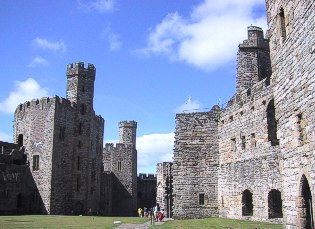 outer wall (left) and inner wall (right) of Caernarfon |
 an arrow slit in the outer wall |
"Whenever you see something as impressive as these walls, you've got to ask, 'Why?'" our guide explained. "Of course, the answer was 'defense.' Since most of you are from the U.S. it will be difficult for you to imagine a leader committing a huge percentage of the annual budget to building defensive capability that will most likely prove to be ineffective."
That got a nervous titter out of us, because one needn't be very attentive to understand that the British are almost unanimously opposed to George Dubya's Star Wars program, and have nothing but contempt for Tony Blair, their prime minister, who seems to be infatuated by everything the Dubya does. |
Building Caernarfon Castle cost King Ed 90% of his annual income, and when the cost over-runs were duly reported, he decreed that the inner walls on the town side not be built. When, a year later, the townspeople revolted and took over the castle, he ordered that the inner walls be built, but to a simpler design. The castle was never finished.
Most rooms above the ground floor were residential chambers for the knights who lived in the castle, and the castle was designed to be held by very few men. In the late 16th Century, when the roofs had been off for 80 years and living conditions were distinctly sub-optimal, 24 men held the castle against a republican mob. |
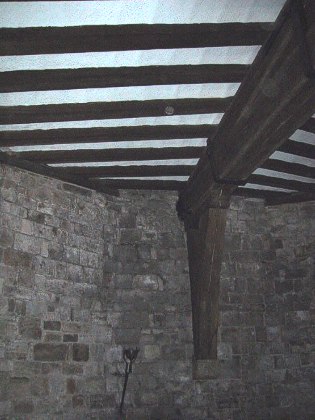 reconstructed floor joists above a storage room |
 from atop one tower toward the river |
Like Conwy Castle, Caernarfon was built beside a river to improve the defensive situation as well as to facilitate delivery of stones from the quarry by barge and, if necessary, the flight of the beseiged king via the watergate ...which, at Caernarfon, was never finished. |
Also like Conwy, Caernarfon was built at one corner of a walled town, although (unlike Conwy) Carenarfon long ago spilled outside the walls. In the 19th Century it was the main shipping point for the slate that "roofed the world."
Above the ramparts of the Eagle Tower, of which not one stone has been replaced in nearly 600 years, some of the vestiges of romanesque details -- statues of the heads of famous men -- still provide perches for sea gulls. |
 the town wall from the top of Eagle Tower |
 Eagle Tower from within the castle ward |
Eagle Tower is the largest castle tower in England, and despite its exposure as the most seaward of the castle's towers, it is remarkably solid. The stonework is superb. Granite of several colors was used for facing stones, but limestone, much easier to shape, was used around all openings and for decorative details. Over the centuries, the granite has fared better than the limestone.
The lower inner castle wall (right) was thrown up rapidly, but the outer wall is unique among British castles in that the wall is doubled, with rooms and passageways in the wall. Ed and his French architect tested several other innovations at Caernarfon, including three shooting angles from within through a single arrowslit in the outside, a water catchment system, and water piping to the kitchen and many rooms. |
There's more artifice here than at Conwy, and a more unified vision of what a castle ought to look like. One telling detail is the classic "Caernarfon Arch" with rounded shoulders and a straight lintel. It was undoubtedly better built, and a larger and altogether more impressive castle, and thus lacks the "down home" feel of Conwy. Because of its status as something of a national shrine -- more on that below -- it's better kept than Conwy.
We ate lunch sitting on a bench in what was once the refectory, happily watching the people gawk and explore. Then we resumed our own gawking and exploring.
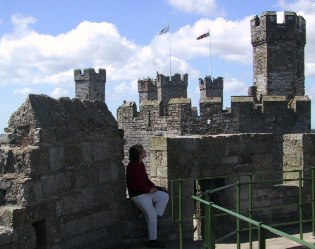 |
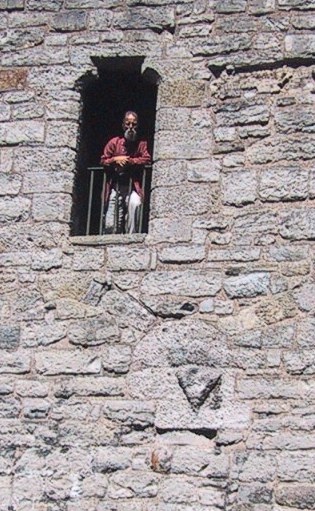 an example of the "Caernarfon Arch"
photo credit: Rochelle Elkan
Our guide emphasized again that living conditions weren't materially worse than at present in Northern Wales "...which is not to say they're good; it's still bitterly cold indoors in winter." |
But there was glass in the windows, running water in many rooms, indoor "amenities" -- garde-de-robes -- first door on the left outside every chamber, and 14 chapels!
As noted before, Caernarfon was never finished, as can be seen by the stub walls two photos below. In 1646, Cromwell identified the castle as a symbol of monarchy and ordered it torn down, but after dismantling the small internal buildings -- refectory, kitchens -- the townsfolk (who were getting the stones for building) realized that the castle was too massive, and left it standing. |
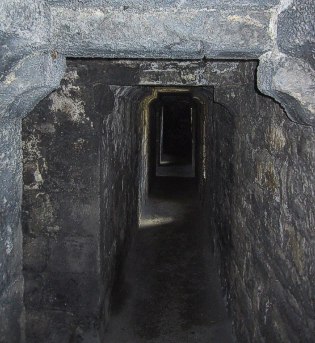 a corridor in the lowest level of the outer wall |
 The window in the "birth chamber" |
Caernarfon is familiar to all who follow The Royals as the site where, once a generation, the Prince of Wales is brought for his investiture. And how long has this tradition gone on? Since 1911, when it was deemed expedient by the then Prime Minister to solidify Welsh loyalty by having the Prince "come from Wales." How, exactly, was that to be done? Simply by creating a legend, that King Ed's son, the first Prince of Wales, was born in a chamber right in this very castle, you know, the little chamber in Eagle Tower with the stained glass window... |
|
...Only problem: the tower wasn't completed until fourteen years after the son was born, probably in a wooden house on the building site.
The second investiture, of Prince Charles, brought a nice infusion of cash to spruce up the castle, build a slate dias and a slate throne, and fix up the "waving arch" where the never-finished ramp into the town would have been built. The Queen came, of course, and she and her son waved to the throngs in the parking lot below, thereby securing once again the loyalty of the Welsh.
Caernarfon town was getting ramped up for their annual festival, and we were happy to catch our bus back to quiet Conwy in time to walk along the wall to our vegetarian restaurant.
|
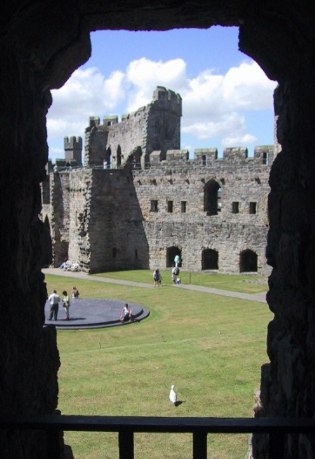 unfinished walls and a corner of the Investiture Dias |













